2013 Polaris 600 Rush Pro-R vs. 2013 Ski-Doo MXZ X 600 E-TEC

We pit Ski-Doo's rMotion against Polaris' Pro-Ride
For 2013 the battle for snowmobile dominance gets extremely serious as Polaris, currently in second place and closing in on Ski-Doo’s Number One standing in sled marketshare, wants to reclaim the snowmobile market dominance it enjoyed from the 1990s up to the stunning sales success of Ski-Doo’s REV models. Buoyed by its overwhelming sales leadership in the western powder market with its vastly popular and powerfully lightweight RMK models, Polaris promotes its snowmobiles as “terrain dominators,” which it hopes to expand to real-world sales domination.
As most serious snowmobilers know by now, whatever love and brotherhood there was among the sled manufacturers took a blow when Ski-Doo’s parent company, Bombardier Recreational Products (BRP), filed a patent infringement lawsuit against Arctic Cat late last year. This June, Polaris announced its own patent lawsuit against BRP, citing infringements of Polaris suspension designs by Ski-Doo. While no specifics were spelled out, logic suggests that Ski-Doo tripped over some patents granted to Polaris for its Pro-Ride rear suspension. Of course, we won’t know that as a fact until the filings are made public – if ever!
What we have heading into 2013 are two snowmobiles with similar ride and performance characteristics vying for your dollars. The 2013 Polaris 600 Rush Pro-R and the 2013 Ski-Doo MXZ X 600 E-TEC are both exceptionally worthy designs. And we like them both, perhaps, one a bit more.
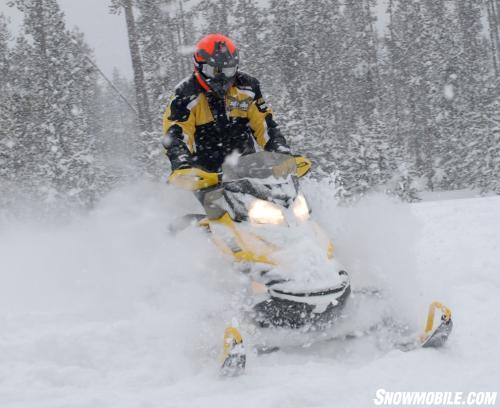 Ski-Doo’s MXZ X lets you lead a double life as a groomed trail performer and as a rough trail powder buster.
Ski-Doo’s MXZ X lets you lead a double life as a groomed trail performer and as a rough trail powder buster.Let’s get the suspense out of the way. We like the Ski-Doo more. Not a lot more, but enough to make it our first choice among what are two sleds that are about as much the same as different manufacturers could make them. Styling is different. There will be no mistaking the Ski-Doo for the Polaris. From a specifications study, they are amazingly close, but with enough variation to give you true choice.
The power edge goes to Polaris and its Liberty 599cc liquid-cooled twin. The semi-direct Cleanfire 2 fuel injection system maximizes the Polaris-built two-stroke’s horsepower, which we found quick and rev-ready off the line and in pulling the sled out of a corner. Plus, the Liberty twin offers a few ponies more in head-to-head dyno pulls. Depending on where you get your information, the Ski-Doo engine manufacturer claims a top power rating right around 120 hp. Polaris suggests its 600cc twin ramps up 125-plus ponies. Various dyno outlets report as low as 113 to 115 for the Ski-Doo and right around 120 for the Polaris. Regardless of the source, there does seem to be about a five horsepower advantage for the Polaris 600.
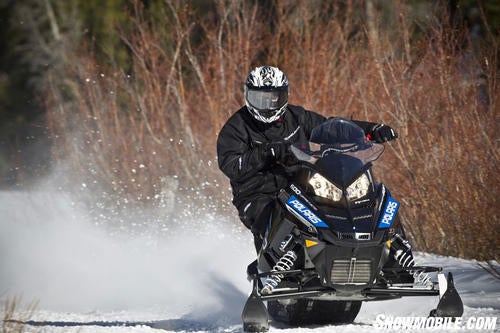 New race-bred front suspension and Pro-Steer skis help make the 2013 Rush excellent in the corners.
New race-bred front suspension and Pro-Steer skis help make the 2013 Rush excellent in the corners.When you literally weigh in power to weight based on the Rush claimed weight of 464 pounds versus the Ski-Doo’s claimed 462 pounds, you get a power to weight advantage that favors the Polaris – very, very slightly!
The advantages of the Liberty twin can be overlooked, as the direct-injected Rotax mill will give you better oil and fuel usage. Plus the E-TEC offers a programmed summerization feature that is handy when you go to store your sled at the end of the season. This mode automatically fogs the engine to protect its innards over the summer. It’s not a huge deal considering that you can do it yourself on the Polaris. This is the same concept as fogging your outboard for winter storage. The Ski-Doo system is borrowing from Evinrude, which is owned by BRP and is the basis for the snowmobile E-TEC system.
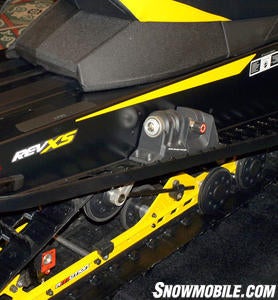 Ski-Doo offers rMotion with an optional Quick Adjust System that features external easy-to-reach adjustments for the torsion springs and gas shock.
Ski-Doo offers rMotion with an optional Quick Adjust System that features external easy-to-reach adjustments for the torsion springs and gas shock.We give the Polaris the edge in on-snow power performance. In the handling comparison, we have mixed reviews. Once you understand the actual simplicity of the Ski-Doo MXZ X rMotion, you may prefer it. The explanatory goobledy-gook as presented in black and white appears daunting. A quick review of the many YouTube explanations will make you very comfortable at setting up your own rMotion-equipped sled. One recommendation we’d make is to seriously consider using the “sport” rear shock setting rather than the “high performance” one. Unless you make a practice of dropping off giant moguls, you’ll be surprised at just how supple and responsive the “sport” setting can be.
For us we find that the internal progressive action of this suspension works well in day-to-day riding. If fine tuning is your thing, opt for the Quick Adjust System as the torsion springs can be hydraulically tuned for as much as 40 percent more preload by a twist on the port side adjuster. Additionally the right-side adjuster lets you play with shock compression. Plus, there are multi-position cam blocks to control weight transfer, more or less. Long time Ski-Doo riders know that this company has used cam-block adjustments over the decades for fine-tuning ride. For 2013 the concept endures, but is now one of several steps to maximizing and personalizing ride quality.
Once you get this suspension set to a basic happy range, you can make little changes to get even happier to meet changing trail conditions. The overall combination of progressive torsion springs combining with top-notch gas-charged shocks gives the MXZ X 600 E-TEC a truly amazing ride.
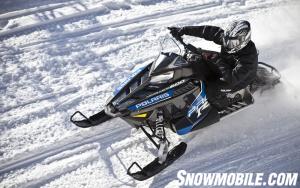 Polaris designed the Pro-Ride suspensions to handle both groomed and rough trails equally well.
Polaris designed the Pro-Ride suspensions to handle both groomed and rough trails equally well.While Ski-Doo manages to house all of its base rMotion suspension set up inside the skid frame, Polaris opted outside the skid for the Pro-Ride. Since its debut on the 2010 Rush, the Polaris design has evolved to make the Rush one of the best riding sleds on the market. We’d rate it comparable to the rMotion, but in on-snow real-world riding we’d chose the rMotion first with the Pro-Ride a very close second. In model year 2013 the Pro-Ride has become what we thought it would be from the get-go. In its first iteration, the Pro-Ride suffered a bit in our estimation. To get the external rear shock mounted required rising the ride height, which upset handling and rider-to-sled cornering balance. If you’ll look at the first year Pro-Ride in comparison to the 2013 version, you’ll note that the ride height is lowered somewhat as the external shock is flatter. We also think that the first Pro-Ride was handicapped by the front suspension, which was upgraded to what Polaris calls its “race” sled specifications. And that also resulted in a more responsive front shock. These evolutionary changes all work part and parcel to giving the 2013 Pro-Ride a very responsive and steady ride/handling package. Our major complaint now centers to shock accessibility. As the shock position evolved, the ability to grab the shock/spring and make tuning adjustments has been impeded.
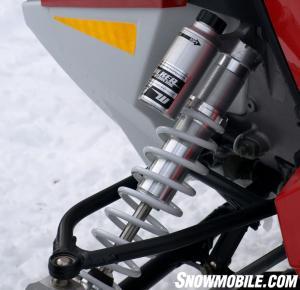 Walker Evans gas-charged shocks with compression adjustments are exclusive to Polaris snowmobiles.
Walker Evans gas-charged shocks with compression adjustments are exclusive to Polaris snowmobiles.Our feeling is that the Pro-Ride offers as much compliance as the rMotion, but it takes a bit more doing to fine-tune it. That’s our opinion. We favor the Walker Evans shock package of the Polaris over Ski-Doo’s combined HPG and KYB choice. Since our season-long affair with the first Rush Pro-Ride, we’ve been impressed with just how operationally functional the Walker Evans shocks can be. We are not shock tuning experts, but we found the Rush Pro-R shock package extremely rider-friendly.
In essence we are splitting the difference between the Polaris and Ski-Doo as to ride. There are things we like more about the rMotion, but our preference lies with the Walker Evans equipment on the Polaris.
Onboard either sled you’ll note a feel that is eerily similar. Now that Ski-Doo has gone to the new XS platform with its more integrated panels and styling, the MXZ X regains some uniqueness. Of course, it wasn’t the Ski-Doo copying the feel of the Rush, but vice versa. From the first-ever time we sat aboard a Rush, we had the sense that Polaris not only used the MXZ as its model, but, perhaps, unwittingly captured its feel. You fit similarly on both sleds, but that may be the nature of ride-forward. The engine and drive clutches have to be mounted in similar low and rearward positions. The rider then must be advanced forward to balance the centering of the sled’s mass.
For 2013 we give the 600 Rush Pro-R a definite plus in the ergonomics department. Polaris moved to a wonderful one-piece handlebar with a very nice curvature built into it. We prefer this to the straight aluminum and hook ends of the MXZ. While both sleds are designed to encourage aggressive cornering, the 600 Rush gives you an edge both with the newly added handlebar set and the new-for-2013 Pro-Steer skis, which really grip the corners and work exceptionally well with the Pro-Ride front A-arm front suspension. Here the edge goes to Polaris.
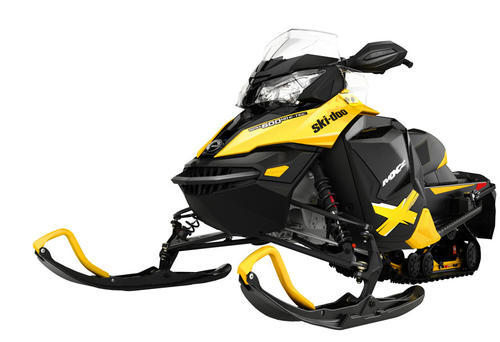 Ski-Doo’s MXZ X comes on a new-for-2013 XS platform complete with integrated panels, rMotion suspension and a direct-injected Rotax two-stroke twin.
Ski-Doo’s MXZ X comes on a new-for-2013 XS platform complete with integrated panels, rMotion suspension and a direct-injected Rotax two-stroke twin.For overall creature comforts it’s hard to beat the French-Canadian Ski-Doo designers. The MXZ X features a new warm glove box that utilizes engine heat to keep a spare set of goggles or gloves dry and warm. The Rev-XP X seat offers added storage. The Polaris 600 Rush saddle will be comfortable as it comes from the long haul Adventure model. Both are fashioned for sport and comfort. Other than storage options, both sleds will be exceptionally good for hard days of play or high mileage jaunts.
We’d like to be very definitive and say that one or the other sled outshines the other. Both work very well in serving essentially the same rider. Power-wise the Polaris gets the nod. Handling and ride are split decisions, as the rMotion with Quick Adjust System seems to offer greater tuning capabilities. But the front end of the Rush Pro-R sticks better in corners. As for day-to-day living, we like the added perks of standard electric start for the Ski-Doo MXZ X 600. Since both come with electronic reverse neither sled gets an advantage there. But the Ski-Doo does have that seat storage and warm box. While the pricing favors the Polaris, if you added electric start to the Rush, that difference would be gone.
All in all, it’ll really come down to whether you want to be a Ski-Doo or Polaris rider. And, maybe that’s the real point of the lawsuit. Since Ski-Doo’s rMotion matches any perceived advantages of the Rush’s Pro-Ride, there really isn’t a compelling difference between the two sleds. Without rMotion there is and that might figure into more sales for the Polaris Pro-Ride models.
| 2013 Polaris 600 Rush Pro-R | 2013 Ski-Doo MXZ X 600 E-TEC | |
| Engine | Polaris Liberty Cleanfire 599cc, twin cylinder, two-stroke liquid-cooled; Cleanfire 2 fuel injection | Rotax 594.4cc, two-stroke twin; liquid-cooled; E-TEC electronic direct injection; RAVE exhaust |
| Horsepower | 125+ | 120 |
| Drive | Polaris P-85 drive; P2 driven with PERC electronic reverse | Ski-Doo/Rotax TRA III drive with QRS driven; RER electronic reverse |
| Front Suspension | Polaris Pro-Ride — 9-in maximum travel; Walker Evans Piggyback compression adjustable shocks; Pro-Steer skis | Ski-Doo dual A-arms with spring over HPG Plus gas shock; up to 9-in travel |
| Rear Suspension | Polaris Pro-Ride parallel rail; 14-inches of travel; Walker Evans compression adjustable shocks | Ski-Doo rMotion parallel slide rail with HPG Plus center shock & KYB Pro 36 gas shock at rear; up to 15.5-in travel (Quick Adjust system optional) |
| Length | 108.0 in | 114.4 in |
| Width | 48.0 in | 47.9 in |
| Height | 46.0 | 47.6 in |
| Ski Stance | 42.5 in | 42.4 in |
| Track | 15x121x1.25 RipSaw | 15x120x1.25 RipSaw |
| Weight | 464 lbs (claimed) | 462 lbs (claimed) |
| Brake | Polaris Phantom hydraulic with lightweight disc | Brembo hydraulic racing disc with stainless steel braided brake line |
| Features | Standard: Fixed 4.5-in riser; Multifunction gauge; new curved handlebar; Pro-Ride Adventure seat Optional: 12v-DC outlet; varied height and/or colored windshields; storage bags | Standard: REV-XS chassis; aluminum handlebar with J-hooks; multi-function gauge; REV-XP X seat with rear storage; “warm” glove box; RER electronic reverse; electric start Optional: rearview mirrors; storage bags |
| Fuel Capacity | 11.0 US Gal | 10.6 US Gal (Premium Fuel) |
| MSRP | $10,799 | $11,499 |
| Full Specs | Here | Here |
Related Reading 2013 Polaris Indy 600 vs. 2013 Ski-Doo MXZ Sport 600 2013 Arctic Cat Sno Pro 500 vs. 2013 Yamaha Phazer RTX 2012 Ski-Doo MXZ TNT 600 E-TEC Review 2013 Polaris 600 Pro-RMK 155 Review – Video




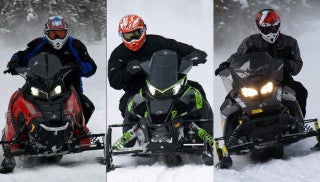



 Your Privacy Choices
Your Privacy Choices